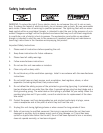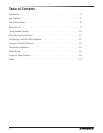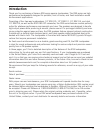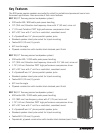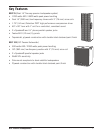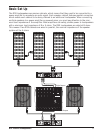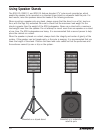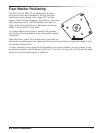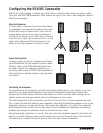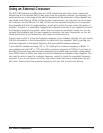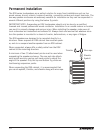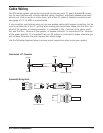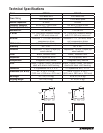
8
Input Connections
The RSX jack plates feature parallel speaker connectors. This enables you to directly connect an
extension cabinet to an RSX speaker.
Only use one ¼" or Speakon® connector as an input connector from an amplifier. Typically,
you will only connect a single extension cabinet to an RSX cabinet, but it is possible to daisy-
chain multiple cabinets. When wiring multiple cabinets in parallel, attention must be paid to
the overall impedance of the loudspeaker system, and the minimum load impedance of the
amplifier. Please see the chart below for typical impedance calculations for multiple speaker
arrangements.
Typical Impedance Calculations
16Ω + 16Ω = 8Ω
8Ω + 16Ω = 5.3Ω
8Ω + 8Ω = 4Ω
8Ω + 16Ω + 16Ω = 4Ω
16Ω + 16Ω + 16Ω + 16Ω = 4Ω
4Ω + 8Ω = 2.7Ω
4Ω + 4Ω = 2Ω
It is recommended, especially for installation applications, to use Speakon® style connectors
because they lock into jacks providing a secure connection, are able to handle high current, and
the contacts do not cause a momentary short when connecting to an amplifier or speaker cabi-
net.
INPUT
INPUT
OUTPUT
When speakers are connected in parallel, the impedance is reduced. The formula to calculate
the total impedance of your speaker system is:
1/R
t
= 1/R
1
+ 1/R
2
+ 1/R
3
+ … 1/R
n
where “R” is the impedance of a speaker cabinet.
If all speakers have the same impedance, the total impedance will be equal to the impedance of
a single speaker divided by the total number of speakers. For example, if you have two 4 Ohm
speakers connected in parallel, the total impedance is 4 divided by 2, or 2 Ohms. You must
be careful when connecting speakers in parallel to an amplifier. The impedance can quickly
fall below safe levels. This is especially true when connecting speakers in parallel to a bridged
amplifier.





